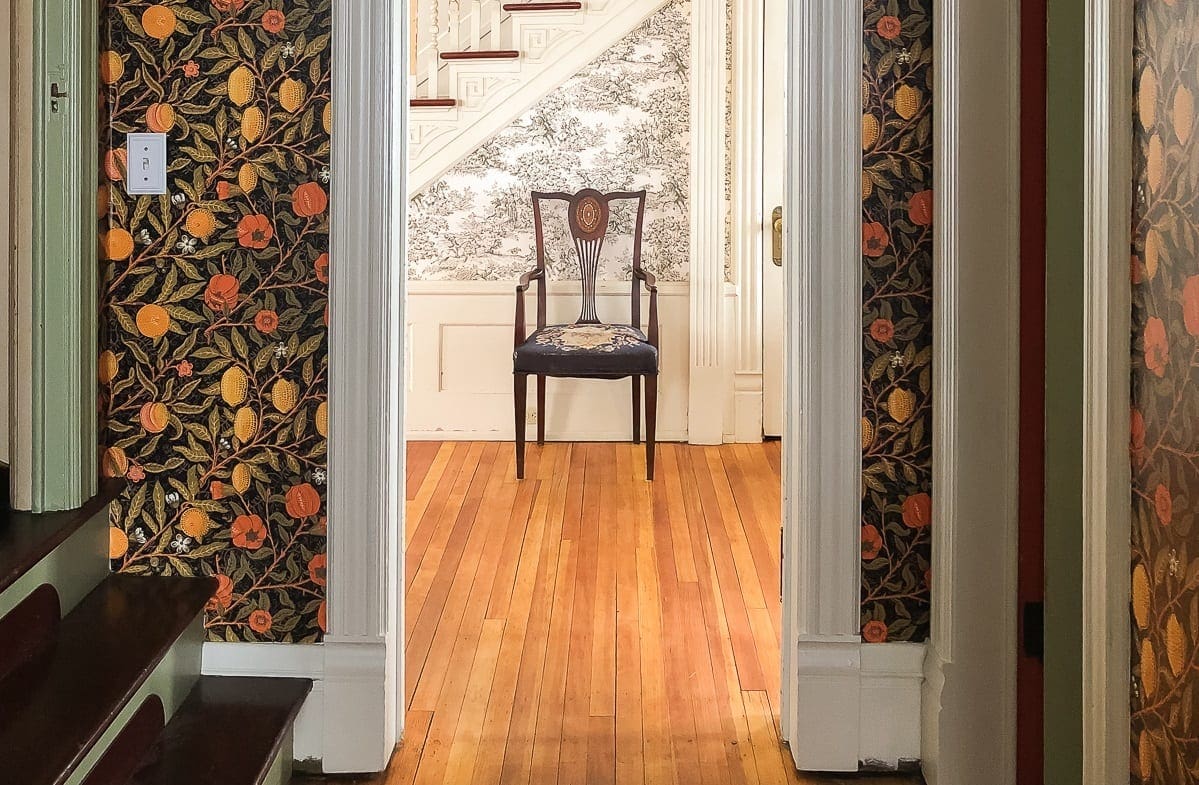Although I haven’t mentioned the front entry in a month or two, I have been doing plenty of work behind the scenes. The wallpaper I chose from Spoonflower continues to make us happy, but the busy pattern is testing my developing ability to select decor. Rather than rushing any decisions, I have been taking my time. Slowly, I am starting to see the final picture in my head, and I think everything is going to be OK. Today, I believe that. Tomorrow, ask me again.
The most significant change since the last update is that I started painting the woodwork. Also, noteworthy, I am not using any of the three colors that I shared in the Choosing Paint post. It turns out that the perfect shade was lurking in our basement the whole time. It’s Sail Cloth by Benjamin Moore.
Initially, I bought it for some other project that I cannot even remember. It’s a satin finish in the Advance line. I am kind of kicking myself that I did not use the matte finish, but I only had satin on hand.
Let’s Talk About Paint For a Sec.
If you glaze over at the idea of paint development, skip ahead to the next section. If not, put on some montage music, and let’s talk about some very superficial science.
Benjamin Moore Advance is a modern alkyd. Oil paints were the original alkyds. They wear like iron and create a smooth glass-like finish. The downside is that oil alkyds can be frustrating to use. You have to be quick and committed to not reworking areas that are still wet. Also, they take a long time to dry, clean-up is a toxic waste bear, and they are higher in VOCs, which pollute the air inside your house.
Some states like California passed laws requiring more environmentally-friendly paints, and they banned the disposal of oil-based paints. While I was too bored to read the entire architectural paint section of the https://leginfo.legislature.ca.gov/ website to see if the sale of oil paint is officially banned in California, the bottom line is that it’s impossible to find it there. Your state may have similar regulations, and much of the US is phasing it out.
Enter polyester alkyds such as Benjamin Moore Advance and Sherwin-Williams ProClassic. For reference, I used the SW ProClassic on the wainscoting in the guest bath and on the cabinets in the laundry/office. I used BM Advance on our giant front door, but I don’t have an after shot of that yet.
C2 is another choice for a modern alkyd that gets good reviews, and I know the options do not stop with the three I mentioned. These modern alkyds wear exceptionally well, and they mimic the look of oil paint. Really! They also have lower VOCs, and the clean-up is a breeze.
You may now revoke my preservation card because I am a fan. Modern alkyds? Yes, please.
This concludes the Miss Frizzle portion of my post. Back to the front entry.
Edited 1/29/20: Please read the comments of this post for some additional observations about using Advance and ProClassic.
Prep: Always Prep
As a reminder, there are seven door openings and one cubby with full rosette trim. That is pretty much a full rose garden. First, I scrubbed everything with tsp-substitute and deglosser. Then, I repaired all the baseboards. They were pretty chewed up from years of abuse.

I scraped off the loose bits and sanded the edges. Then I filled in the chips and cracks with MH Ready Patch. This was my first time using this product. Over on Instagram, I saw Scott, from The Craftsman Blog using it in his house, so I gave it a whirl. If it is good enough for a pro, it’s good enough for me. The verdict? It smells awful, but it is easy to work with, and it sands like a dream.
For this type of work, I don’t aim for complete perfection since the bumps and dings give BHH some of its character. In photos, painted over chipped areas are unnoticeable. In real life, that type of corner-cutting looks like a rush job. Take your time.

Painted Woodwork: In Process
Earlier in January, I painted all of the baseboards, and this week, I completed two door openings.

It is crazy to me how white Sail Cloth looks in this light, but I like it. I’m still not 100% sold on the sheen, but I am 100% sold on finishing this job ASAP. Repainting sounds like a terrible idea.

Next up is shoe molding and crown molding. I finally decided how I want to address the curved walls, and I am waiting on some samples from a trim company.
There you have it–real-time progress. You may long for my One Room Challenge speed of yore, but this is my life right now. Working in fits and starts still counts, and the job eventually gets done too.

PS: How is it almost February?





12 Comments
Sherrill
Love it!
Stacy
Thank you, Sherrill!
Maggie
Thank you for sharing this information! I need to repaint all of the trim in my 1920s house, but I’ve hesitated to start because I’m not sure what paint to use. Does this paint level well? Do you have to be super careful about not reworking areas? How is the coverage? (The last paint I tried for trim took 4 coats.)
Stacy
Thank you for asking these questions, Maggie. This important info should have been included in the post, and I’ll add it. The ProClassic and Advance both level very well. It’s not great to re-work either, but the Advance takes it better. 🙂 I add a tiny bit of Floetrol to both, and that helps. The coverage is two coats for each with a couple of touch-up spots here and there.
faellie
You can make your own trim for a curved wall. You need a straight piece of trim to start with. You then cut it across in diagonals to make wedges. You then glue and clamp the wedges together with all the wide sides of the wedge together to create the curve. You need to either measure and calculate (or go with trial and error) to find the right angle at which to cut the wedges for your particular curve. I look forward to the future blog post on this!
Stacy
Yes, this is an excellent method. Thank you for mentioning it. I’m excited to write that post because I get such a kick out of problem-solving.
Vanessa
I think that’s a great color and much better than a bright white, it’s sort of vanilla. When we lived in California and I had a new house to work on I had oil paint driven down from Oregon, I love the result it gives and I actually like the smell too (call me crazy). Reworking oil paint is a problem but it is with latex too and it’s sort of a bad habit on my part, I need to paint the area and move on.
Well done!
Stacy
Thank you, Vanessa. Oil paint is contraband in California. LOL Honestly, I don’t mind the smell, either. I just can’t afford the brain cells. 😀
Chris
I definitely like the white, it really makes the wallpaper the star of the show.
Stacy
Thanks! 🙂
Ragnar
Great choice!
I’d also think satin is the most appropriate finish as it’s closest to what linseed oil paint back in the 19th century looked like. Personally I love glossy as that’s what I grew up with (all woodwork repainted in the 70s, it’s always been light grey or white though) but it’s quite annoying to get perfect.
Matte on the other hand is perfect for walls.
Stacy
Thanks for weighing in, Ragnar.